Development and Characterization of the Midrib of Coconut Palm Leaf Reinforced Polyester Composite
2015-12-12NeerajDubeyandGeetaAgnihotri
Neeraj Dubey and Geeta Agnihotri
Development and Characterization of the Midrib of Coconut Palm Leaf Reinforced Polyester Composite
Neeraj Dubey1and Geeta Agnihotri1
In this paper,midrib of coconut palm leaves(MCL)was investigated for the purpose of development of natural fiber reinforced polymer matrix composites.A new natural fiber composite as MCL/polyester is developed by the hand lay-up method,and the material and mechanical properties of the fiber,matrix and composite materials were evaluated.The effect of fiber content on the tensile,flexural,impact,compressive strength and heat distortion temperature(HDT)was investigated.It was found that the MCL fiber had the maximum tensile strength,tensile modulus flexural strength,flexural modulus and Izod impact strength of 177.5MPa,14.85GPa,316.04MPa and 23.54GPa,8.23KJ/m2respectively.Reinforcement of MCL enhanced the mechanical properties of pure polyester,including that of tensile strength(by 26%),tensile modulus(by 356%), flexural strength(by 41.81%),flexural modulus(by 169%)and Izod impact strength(by 23 times),but the compressive strength was adversely affected.HDT decreased due to fiber loading,but increased with weight fraction of fiber content.Moreover,the experimental results were compared with theoretical model(Rule of mixture)and other natural fiber/polyester composites.
Polymer matrix composites(PMCs),Natural fiber,Midrib of coconut palm leaf,Mechanical properties,HDT.
1 Introduction
Due to the increased environmental consciousness,the development of the new materials as natural fiber reinforced plastics are on anvil and growing everyday.In the past two decades,several researchers reported their study on different natural fiber reinforced polymer composites with thermoplastics or theromoset resins as the matrix material and reported appreciable properties of the same[Ratna and Mohana(2011);Omar,Umaru,Asami and Hiroyuki(2005);Wambua,Ivens and Verpoest(2003)]in furniture[Wen-bin,Jian and Yi-xing(2005)],packaging and inautomobile industries[Alves,Ferra˜o,Silva,Reis,M.Freitas,Rodrigues and Alves(2010)].Unsaturated polyester resin is an important matrix material for producing thermoset partially biodegradable natural fiber reinforced composites as it is cost effective,cured at the room temperature,and possessing good mechanical properties and dielectric strength[Ramanaiah,Ratna and Reddy(2013)].One of the important advantages of natural fibers is their free of cost availability in their natural habitat.In tropical areas such as Philippines,India,Indonesia and Shri lanka,coconut palm(cocos nucifera)is a rich source of natural fibers.Coconut palm is produced in 92 countries worldwide on approximately 11.8 million hectares land.Its world production has been estimated to be 61.7 million tons with an average yield of 5.2 tons/ha.[IKISAN,(2012)].Different parts of coconut palm are used for different purposes from structural to medicinal[de Lourdes,Molina,Más,Carbajal,Marrero,González and Rodríguez(2007)].Mechanical properties of fibers from different parts of coconut palm have been investigated and the maximum modulus and strength under tension was found to be 24.7GPa and 191.81MPa for the fibers obtained from the bark of the petiole[Satyanarayana,Pillai,Sukumaran and Pillai(1982)].Coir is an established fiber obtained from coconut palm,it has already been investigated and commercialized[Brahmakumar,Pavithran and Pillai(2005);Sapuan,Zan,Zainudin and Arora(2005)].As Coconut palm is available in abundance in the tropical areas,it is available at very low cost in their habitat.
Considering all the above mentioned factors the midrib of coconut palm leaf(MCL)was investigated in the present study.MCL have the additional advantages of flexural and impact strength as well as availability in semi furnished form as broom sticks(Fig.1).MCL contain 30%cellulose and 16%lignin,indicating their potential for reinforcement of plastics[Venkataswamy,Pillai and Prasad(1987)].
In the present study,a partially biodegradable green composite such as MCL reinforced in polyester resin is developed and tested for different mechanical properties such as tensile,flexural,compressive and impact strength at different weight fraction of fiber reinforcement.Thermal stability of the composite was investigated by heat distortion temperature(HDT)test at different weight fractions.Tensile strength and modulus were calculated by the rule of mixture(ROM)and compared with the experimental results,In addition,the mechanical properties of the present composite was compared with that of other natural fiber/polyester composites(NFPC).
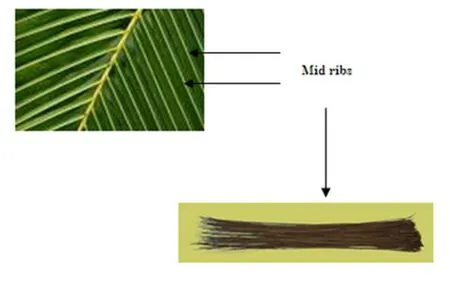
Figure 1:Midribs of coconut palm.
2 Experimental
2.1 Material
MCL were supplied by the Maharaja Broom Works,Bhopal,India.Polyester resin(Grade:VBR 4513)with cobalt naphthanate as an accelerator and methyl ethyle ketone peroxide(MEKP)asa hardener was provided by Parmali Wallace Ltd.Bhopal,India.The resin possessed 500-600 cps viscosity,15-25 min.gel time at 25˚C and 38-40%volatile content.Healthy midribs were selected from stock and cut uniformly.The surface of the selected parts of midribs were finished with the help of a knife and then washed thoroughly in running water for clearing from leaf residues and other impurities.The midribs were allowed to dry first under sun light and then in a hot air oven at 60˚for 8 h.
2.2 Preparation of specimens
Two molds of mild steel were developed,with each mold containing six cavities for producing six specimens simultaneously.Molds have cavities for tensile and flexural test specimens as per the ASTM standards(Fig.2 a,b).Specimens of the impact test were casted in the mold of tensile test(Fig.2 c).Molds were first baked in a hot air oven and then cleaned and polished by Matrox silicon paste,before pouring each time,for preventing sticking of the resin in the mold.Molds for impact test,compression test and HDT test specimens were developed by joining the loose pieces on a surface plate(Fig.2 d).Specimens of the composite for different tests were prepared by reinforcing MCL in the polyester resin at different weight fractions(0,5,10,15,20 and 25%).Polyester resin with 1.5 part cobalt as an ac-celerator and 1.5%(by volume)of MEKP as a hardener were stirred for 2 min and then poured into the molds.Hand lay-up technique was adopted to fill the prepared molds with an appropriate amount of polyester resin mixture and layers of unidirectional MCL fibers.Resin was allowed to cure by the cold setting method for at least 48 h.The specimens were also post-cured at 80˚C for 2 h after removing from the mold.Fig.3 shows photographs of the sample test specimens for different tests of the composite material and Tab.1 shows the details of the specimens developed for different tests.
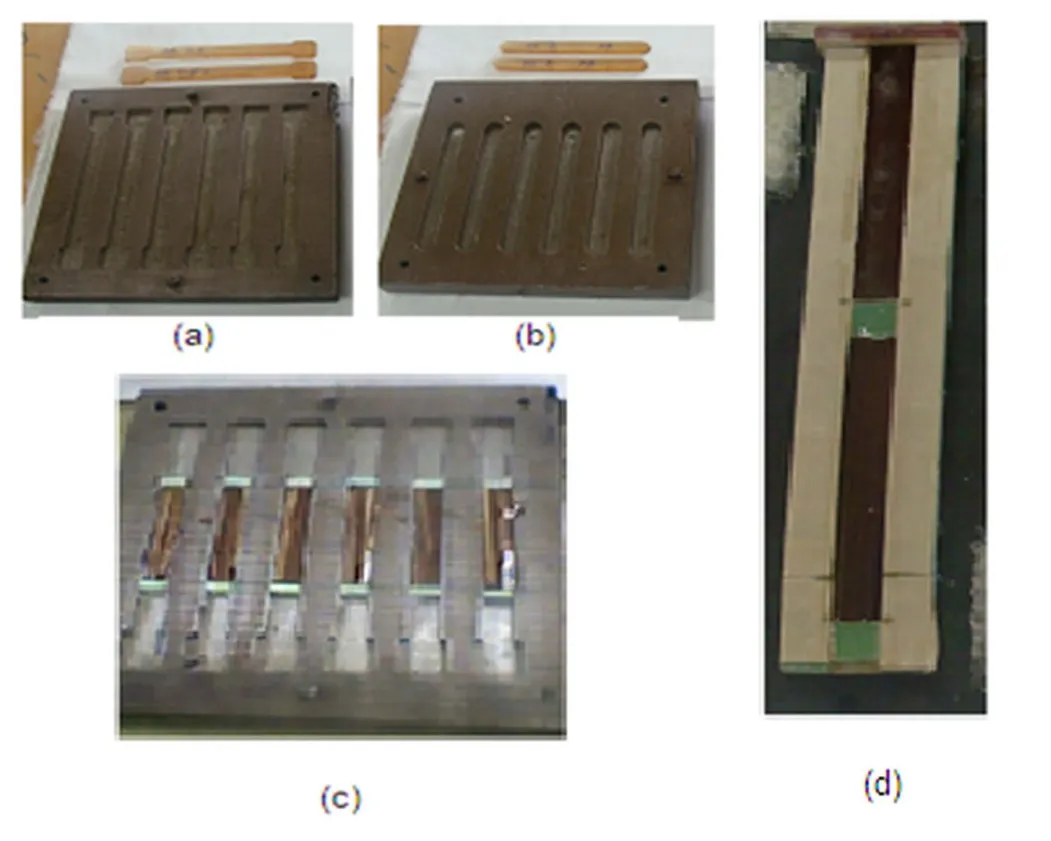
Figure 2:Moulds for specimens of(a)Tensile test,(b)Flexural test,(c)Impact test,(d)HDT test.

Table 1:Details of specimens for different tests.
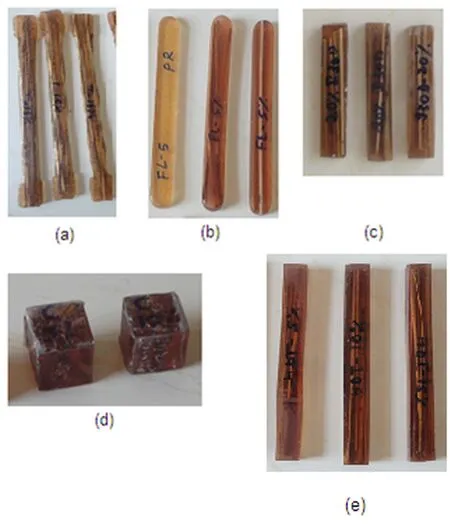
Figure 3:Specimens of(a)tensile test,(b)Flexural test,(c)Impact test,(d)Compression test,(e)HDT test.
2.3 Test performed
The density of fiber and matrix were measured by the liquid displacement method.Moisture content was measured at 23˚C,50%humidity by considering weight differences in five fiber samples before and after drying in hot air oven for 3-4 h at 100˚C.All tensile,compression and flexural tests were conducted on the Instron 3382 UTM.Tensile,compression and flexural strengths as well as the elastic modulus were recorded from the machine generated graph and data.Izod impact tests were conducted on the Tinius Olsen,USA Model IT 504 Plastic Impact tester using notched specimens and HDT tests were conducted on the HDT tester with an initial temperature of 38˚C,with a rise in temperature set at 1˚C/min with air as chamber’s medium.At least five specimens were tested for each type of the test specimen at 23˚C under 50%humidity.
3 Results and Discussion
3.1 Properties of fiber and matrix material
Tab.2 shows the properties of MCL fiber and matrix material.The density of MCL is equal to that of coir fiber.The density of the matrix material was equal to that of fiber suggesting that a composite lighter than the pure matrix material cannot be developed with the tested fiber.MCL fiber was found lighter than the synthetic fibers such as glass fiber,carbon fiber,aramide fiber and natural fibers including cotton, flax,hemp,ramie,and sisal.The tensile strength of MCL was equal to that of coir fiber but its tensile modulus was in the range of jute and cotton fibers[Wambua,Ivens and Verpoest(2003)].Flexural and impact properties of MCL are additional features because they are in the form of sticks that can be considered as a bundle of fibers.The tensile,flexural and impact properties of fiber were greater than those of the matrix material.Fig.4 depicts the machine generated stress-strain curves for different MCL samples.Stress-strain diagram shows 2-3%elongation at the failure,and the behavior of failure was found to be brittle.
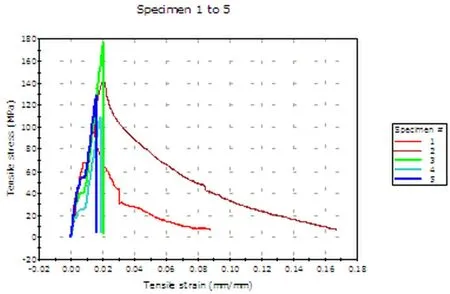
Figure 4:Machine generated stress-strain curves for MCL fiber.
3.2 Properties of composite
3.2.1 Tensile properties
The experimental and theoretical results of the tensile strength of midrib/polyester composite at different weight fractions of fiber loading are compared in Fig.5.Itcan
be observed from the experimental results that,tensile strength increases with the weight fraction of fiber loading from 5%to 15%and decreases abruptly on further increment of the fiber loading,due to an increase in the weaker bonding interfacial region.In addition,at high volume fraction fibers tend to aggregate in the composite,which further weakens the interfacial area[Shalwan and Yousif(2013)].The maximum tensile strength of 49.29MPa and an increase in the strength of polyester by 26%at 15%weight fraction of fiber loading was achieved due to the successful transfer and distribution of the applied load by matrix material to the MCL fiber.Fiber pull-out was observed as the primary mechanism of failure.Tensile strength due to ROM at different weight fractions increases linearly,with higher than the corresponding experimental values at all fiber contents,which is mainly due to the imperfect bonding between the fibers and the matrix as well as due to the manufacturing defects such as air entrapment as a result of exothermic reactions during curing of resin.The difference between the theoretical and experimental values of tensile strength suggest the scope for further improvement in the strength by application of some fiber surface topography alteration.However,the theoretical and experimental strengths were found to be almost equal at 5%weight fraction of the fiber content.
The results for experimental and theoretical tensile modulus of the midrib/polyester composite at different weight fractions of fiber loading were compared in Fig.6.It was found that,in both the cases,the tensile modulus increased with the weight fraction of fiber loading.The tensile modulus of composite at different fiber contents was evaluated from the linear region of the machine generated stress-strain diagram.It was observed that the tensile modulus increased linearly according to the ROM with higher value than the experimental results for 5-20%weight fraction of the fiber content.However,the experimental value of modulus at 25%weight fraction reached even greater value than that calculated by ROM.This remarkablegain in the tensile modulus can be attributed to the fact that,at higher fiber content the matrix fails earlier and the tensile modulus is only contributed by the bundle of fibers.However,the tensile strength decreases after 15%weight fraction of fiber loading,because of which the modulus values above this range are not significant.
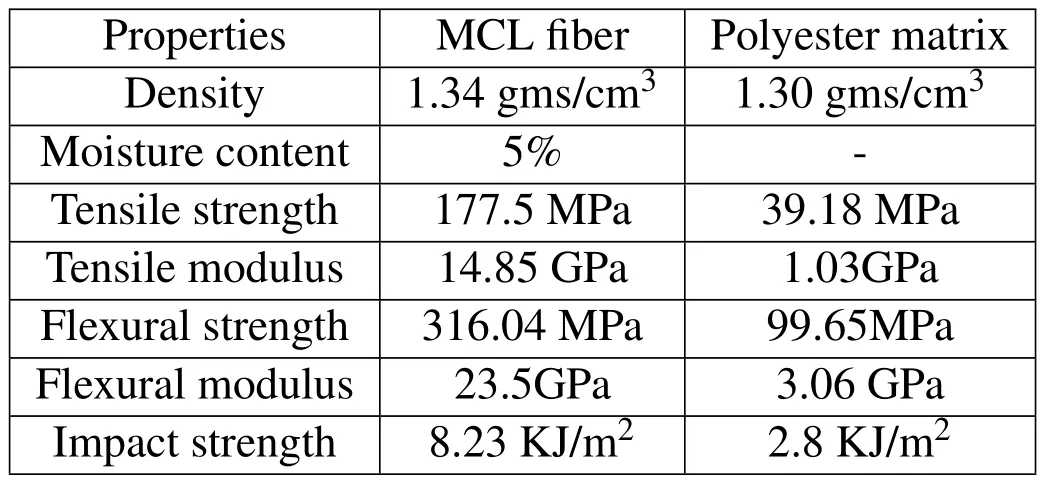
Table 2:Properties of MCL fiber and Matrix material.
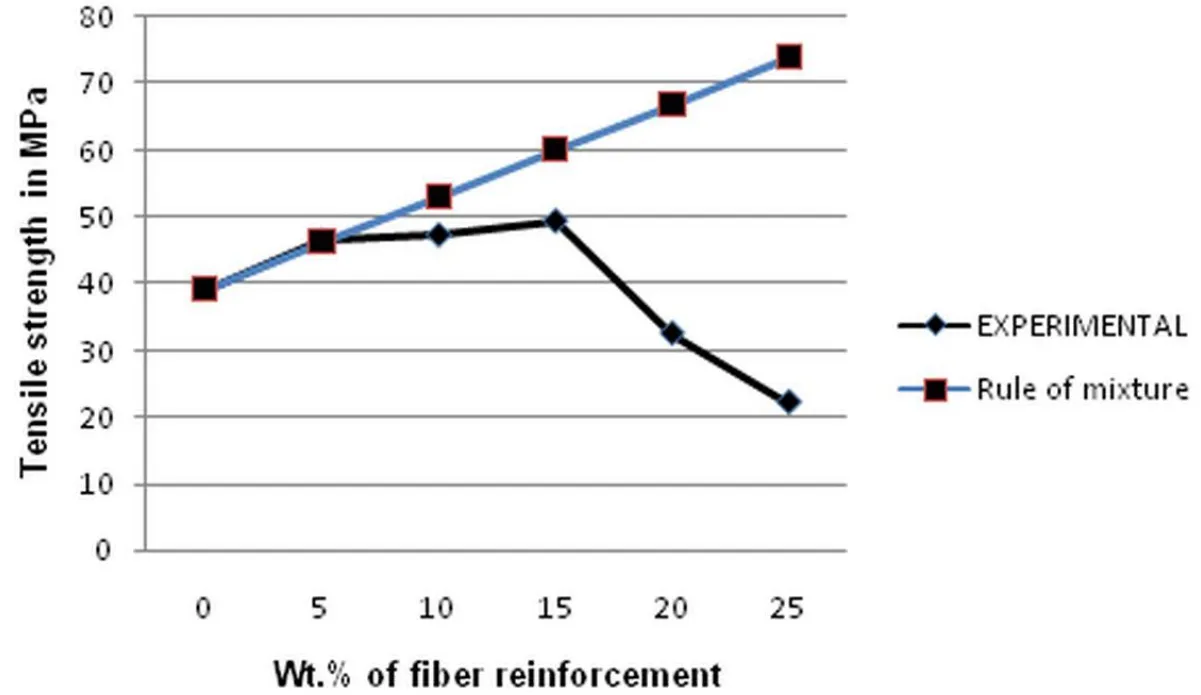
Figure 5:Effect of fiber weight fraction on the tensile strength of MCL/Polyester composite.
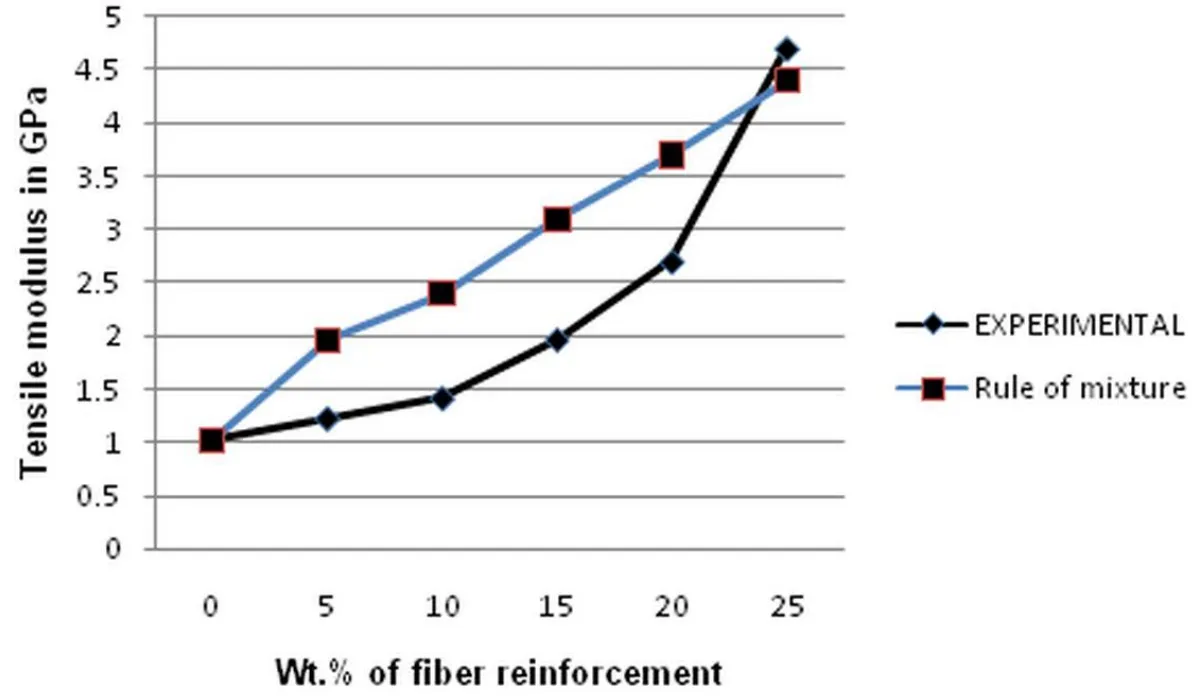
Figure 6:Effect of fiber weight fraction on the tensile modulus of MCL/Polyester composite.
3.2.2 Flexural properties
The effect of MCL reinforcement and fiber content on the flexural strength of polyester is shown in Fig.7.The maximum flexural strength of 141.33MPa and the enhancement of 41.81%in flexural strength of polyester was achieved at 10%and 15%weight fractions of the fiber.The flexural strength of composite increased up to 10%which remains maintained up to 15%over which the flexural strength deteriorates.Fig.8 shows the effect of weight fraction of fiber on the flexural modulus of the MCL/polyester composite.A sharp increase in the flexural modulus was observed with the weight fraction of MCL and the maximum modulus as 8.28GPa and enhancement of 169%in the flexural modulus of polyester was achieved at 25%weight fraction due to the stiffness and high flexural modulus of MCL.Flexural modulus increases continuously with the weight fraction of reinforcement.Failure in the case of bending was mainly due to the pullout of fibers,which is similar to that in the case of tensile failure.
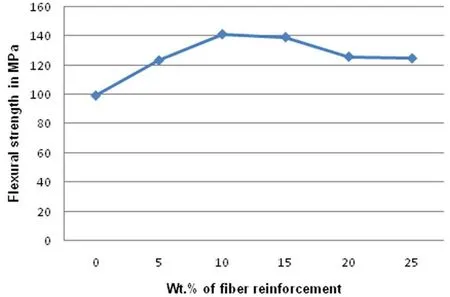
Figure 7:Effect of fiber weight fraction on the flexural strength of MCL/Polyester composite.
3.2.3 Impact strength
Fig.9 shows the effect of the weight fraction of fiber on the impact strength of the MCL/polyester composite.A sharp increase in the impact strength was observed due to the reinforcement of fiber.Highest breaking energy per unit of the shear area of 64.4KJ/m2was recorded at 20%weight fraction which showed an
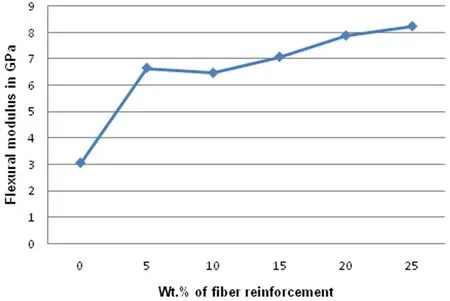
Figure 8:Effect of fiber weight fraction on the flexural modulus of MCL/Polyester composite.
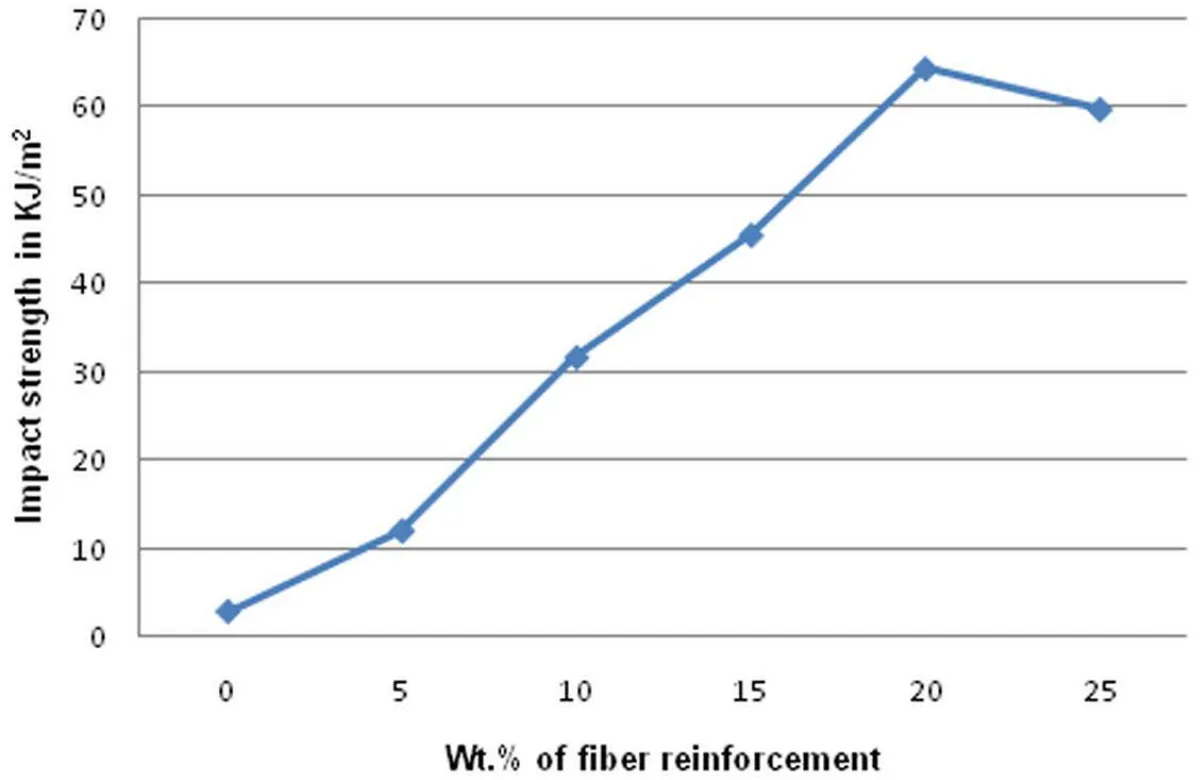
Figure 9:Effect of fiber weight fraction on the Impact strength of MCL/Polyester composite.
enhancement of 23 times in the toughness of polyester.This abrupt increase in the impact strength with the fiber content indicated high-energy dissipation due to the debonding of fibers,which is a sign of weak bonding between a hydrophilic fiber and a hydrophobic matrix material.This behavior corroborates a mechanism of fracture through cracks that spread preferentially between the fiber and matrix due to low interfacial resistance.The greater fracture area associated with the long and aligned fibers,act as a reinforcement for the composite,justifying the higher absorbed impact energy with increasing amount of MCL fibers[Monteiro,Lopes,Nascimento,Ferreir and Satyanarayana(2013)].The impact strength decreases with an increase in the interfacial bonding[Wambua,Ivens and Verpoest(2003)].High impact strength depicts that failure mechanism is mainly due to the pull out of fibers.
3.2.4 Compressive properties
Fig.10 shows the effect of reinforcement of MCL fiber and fiber content on the compressive strength of MCL/polyester composite.It can be observed that the compressive strength of polyester deteriorates due to reinforcement of MCL but the strength seems to build up with the fiber content of range 5-15%.The maximum compressive strength of MCL/polyester composite was 77.65MPa at 15%fiber weight,but deterioration of 16%was observed in comparison to the value of pure matrix.The compressive failure of fiber reinforced composites follows various mechanisms of microbuckling or kinking[Budiansky and Fleck(1994)].The compressive failure was,most probably,caused by the local instability of fibers embedded in the matrix.The local instability of the fiber reinforced composites may be nucleated locally by fiber waviness,free-edge region,resin-rich region and poor fiber-matrix interfacial bonding.This locally initiated failure propagates under incremental load through the laminate,thereby creating a narrow zone called as kink band width within the 0˚plies,which lost structural integrity and collapsed[Jumahat,Soutis,Jones and Hodzic(2009)].In the present study weak interfacial adhesion observed between the fiber and matrix material was mainly due to microbuckling.
3.2.5 HDT test
HDT tests of MCL/polyester composite for different weight fractions of fiber reinforcement were conducted.The results for HDT test are shown in Fig.11,in which the graph was plotted with an average value of HDT for five samples of different weight fractions of fiber reinforcement.The results showed that,HDT of pure resin was 62˚C.HDT of the composite was lower than that of the pure resin,but it increases with the weight fraction of fiber.The lower value of HDT was mainly due to the moisture content in the fibers.
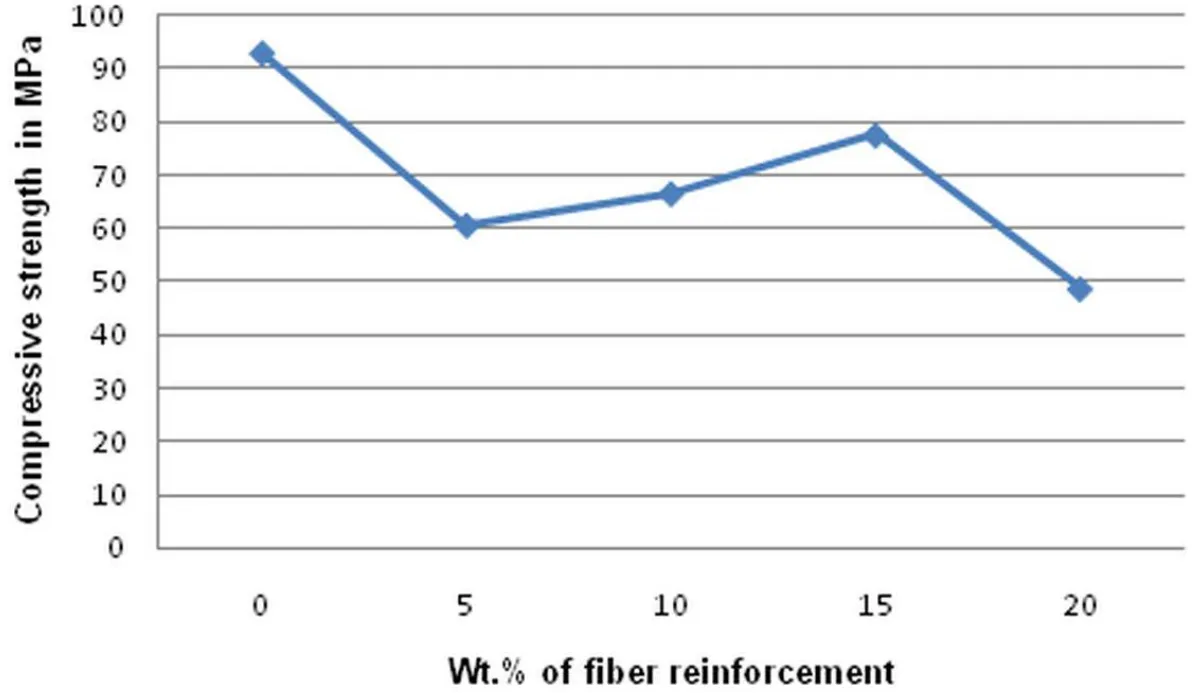
Figure 10: Effect of fiber weight fraction on the compressive strength of MCL/Polyester composite.

Figure 11:Effect of fiber weight fraction on the HDT of MCL/Polyester composite.
3.3 Comparison of mechanical properties
Several factors which influence the mechanical properties of natural fiber/polymer composites including interfacial adhesion,moisture absorption,impurities,orien-
tation, fiber content,manufacturing methods and the physical properties of the fiber and matrix materials.In most cases,natural fiber enhances the mechanical properties of the pure matrix up to a speci fic value of fiber loading,over which the mechanical properties deteriorate.In Tab.3 natural fiber reinforced polyester composites(NFPC)were designated according to their composition,the manufacturing method and the reported journal references.In Tab.4 maximum value of mechanical properties achieved at an optimum fiber content,for different NFPC were compared with those of MCL/polyester composite.It can be observed from this table that the tensile strength of MCL/polyester composite is lesser than that of most of the other NFPC composites except composites with bagass,banana,sisal,and coir fibers.This difference can be attributed to the weaker interfacial strength between the untreated MCL and polyester material.The tensile strength in this case can be increased by adopting some chemical and physical treatment of fiber and by using
advanced manufacturing technologies.Mechanical properties of MCL/polyester composite such as tensile modulus,flexural strength,flexural modulus and impact strength were found to be superior than most of the other NFPC in this study.
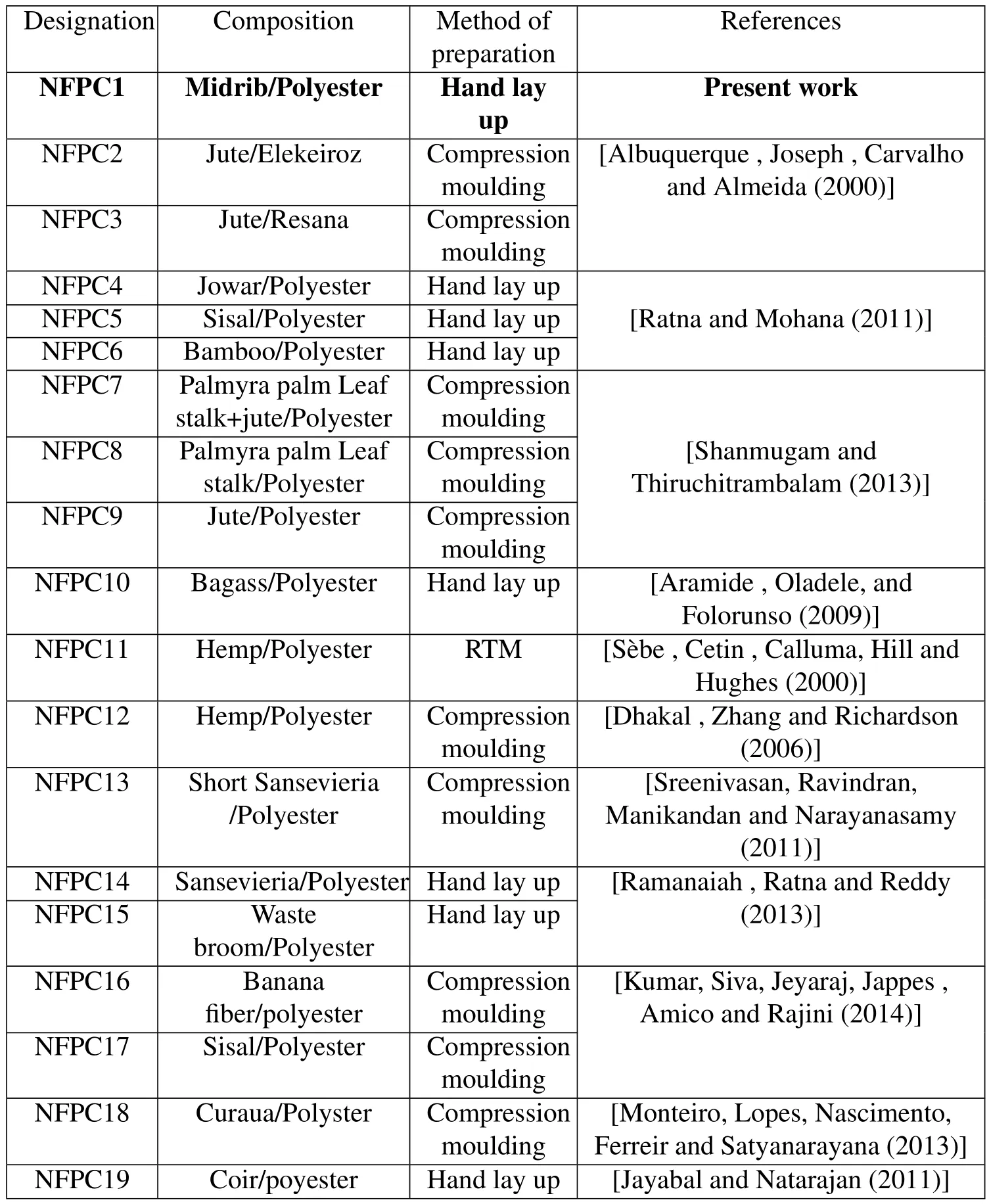
Table 3:Designation of natural fiber reinforced polyester composites for comparison.
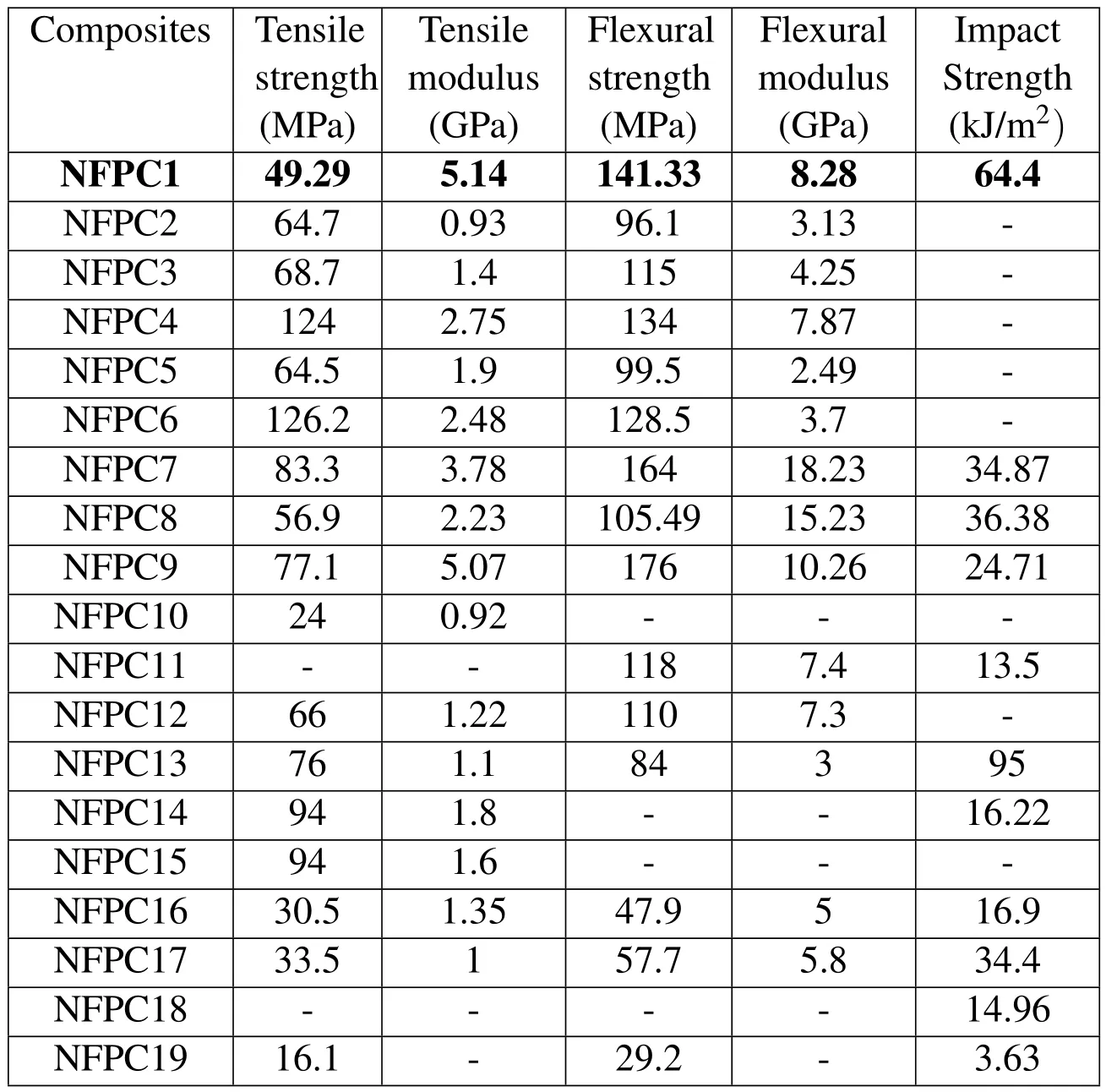
Table 4:Mechanical properties of natural fiber/polyester composites.
4 Conclusion
In the present study,MCL fiber reinforced green composites were successfully developed and their mechanical properties were tested.The following conclusions can be drawn from the results obtained:
•The densities of fiber and matrix materials were the same;therefore,composite lighter than pure polyester cannot be produced.The tensile,flexural and impact strengths of MCL were much greater than that for matrix material and other natural fibers.
•Reinforcement of MCL in the polyester resin enhances all of the mechanical properties,except for compressive strength.The highest value of mechanical strengths was noted at the optimum value of fiber weight fraction.
•The fracture of composites in all cases was mainly due to the pullout of fibers from the matrix which indicated poor interfacial adhesion and the requirement of a suitable surface treatment of fibers for the improvement of the composite strength.
•HDT showed no improvement,but increased with the weight fraction of fiber.
•The mechanical properties of MCL/polyester composite were found to be competitive in comparison to those of other NFPC.
As coconut palm is an abundant crop of the coastal regions,production of MCL-reinforced plastic composite can be a potential source of employment for the rural areas of countries such as Philippines,India and Shri lanka.
Acknowledgement:The authorsare indebted to the ParmaliWallace Ltd.,Bhopal.MP,India for providing assistance for developing material and test facilities during the course of the investigation.We present our sincere thanks to Mr.Bhujang Seth,Mr.Balraj Singh Negi and Mr.Motilal Sharma of the R&D Dept.,Parmali Wallace Ltd.Authors are also grateful to Dr.A.K.Nema and Mr.A.Alagou of CIPET Bhopal,India for providing testing facilities and guidance.
Alves,C.;Ferra˜o,P.M.C.;Silva,A.J.;Reis,L.G.;Freitas,M.;Rodrigues,L.B.;Alves,D.E.(2010):Eco design of automotive components making use of natural jute fiber composites.J.Clean.Prod.,vol.18,pp.313–327.
Aramide,F.O.;Oladele,I.O.;Folorunso,D.O.(2009):Evaluation of the effect of fiber volume fraction on the mechanical properties of a polymer matrix composite.Leonardo El.J.Pract.Technol.,vol.14,pp.134-141.
Arruzazabala,M.D.L.;Molina,V.;Más,R.;Carbajal,D.;Marrero,D.;González,V.;Rodríguez,E.(2007):Effects of coconut oil on testosterone-induced prostatic hyperplasia in Sprague-Dawley rats.J.Pharm.Pharmacol.,vol.59,no.7,pp.995-999.
Brahmakumar,M.;Pavithran,C.;Pillai,R.M.(2005):Coconut fiber reinforced polyethylene composites:effect of natural waxy surface layer of the fiber on fiber/matrix interfacial bonding and strength of composites.Compos.Sci.Technol.,vol.65,pp.563-569.
Budiansky,B.;Fleck,N.A.(1994):Compressive kinking of fibre composites:a topical review.Appl.Mech.Rev.,vol.47,no.6,pp.246-270.
De Albuquerque,A.C.;Joseph,K.;de Carvalho,L.H.;d’Almeida,J.R.M.(2000):Effect of wettability and ageing conditions on the physical and Mechanical properties of uniaxially oriented jute-roving-reinforced polyester composites.Compos.Sci.Technol.,vol.60,pp.833-844.
Dhakal,H.N.;Zhang,Z.Y.;Richardson,M.O.W.(2006):Effect of water absorption on the mechanical properties of hemp fibre reinforced unsaturated polyester composites.Compos.Sci.Technol.,vol.67,pp.1674-1683.
IKISAN(2012):http://Coconut,IKISAN.com/cropspecific/eng/link/ap_coconuthistory.shtml 2012,1-8(October 12,2012).2012,accessed on 15 Feb 2014
Jayabal,S.;Natarajan,U.(2011):Drilling analysis ofcoir–fibre-reinforced polyester composites.Bull.Mater.Sci.,vol.34,no.7,pp.1563–1567.
Jumahat,A.;Soutis,C.;Jones,F.R.;Hodzic,A.(2009):Fracture mechanisms and failure analysis of carbon fibre/toughened epoxy composites subjected to compressive loading.Compos.Struct.,vol.92,no.2,pp.295-305.
Khondker,O.A.;Ishiaku,U.S.;Nakai,A.;Hamada,H.(2005):Fabrication and mechanical properties of unidirectional jute/pp composites using jute yarns by film stacking method.J.Polym.Environ.,vol.13,no.2,pp.115-126.
Kumar,K.S.;Siva,I.;Jeyaraj,P.;Jappes,J.W.;Amico,S.C.;Rajini,N.(2014):Synergy of fiber length and content on free vibration and damping behavior of natural fiber reinforced polyester composite beams.Mater.Des.,vol.56,pp.379–386.
Monteiro,S.N.;Lopes,F.P.D.;Nascimento,D.C.O.;da Silva Ferreira,A.;Satyanarayana,K.G.(2013):Processing and properties of continuous and aligned curaua fibers incorporated polyester composites.J.Mater.Res.Technol.,vol.2,no.1,pp.2-9.
Ramanaiah,K.;Prasad,A.R.;Reddy,K.H.C.(2013):Mechanical,thermo-physical and fire properties of sansevieria fiber-reinforced polyester composites.Mater.Des.,vol.49,pp.986–991.
Prasad,A.R.;Rao,K.M.(2011):Mechanical properties of natural fiber reinforced polyester composites:Jowar,sisal and bamboo.Mater.Des.,vol.32,pp.4658-4663.
Sapuan,S.M.;Zan,M.N.M.;Zainudin,E.S.;Arora,P.R.(2005):Tensile and flexural strengths of coconut spathe- fiber reinforced epoxy composites.J.Trop.Agr.,vol.43,pp.63-65.
Satyanarayana,K.G.;Pillai,C.K.S.;Sukumaran,S.;Plllal,G.K.(1982):Structure property studies of fibres from various parts of the coconut tree.J.mater.Sci.,vol.17,pp.2453-2462.
Sebe,G.;Cetin,N.S.;Hill,C.A.;Hughes,M.(2000):RTM Hemp Fiber-Reinforced Polyester Composites.Appl.Compos.Mater.,vol.7,pp.341–349.
Shalwan,A.;Yousif,B.F.(2013):In state of art:Mechanical and tribological behavior of polymeric composites based on natural fibers.Mater.Des.,vol.48,pp.14-24.
Shanmugam,D.;Thiruchitrambalam,M.(2013):Static and dynamic mechanical properties of alkali treated unidirectional continuous Palmyra Palm Leaf Stalk Fiber/jute fiber reinforced hybrid polyester composites.Mater.Des.,vol.50,pp.533–542.
Sreenivasan,V.S.;Ravindran,D.;Manikandan,V.;Narayanasamy,R.(2011):Mechanical properties of randomly oriented short Sansevieria cylindrical fibre/polyester composites.Mater.Des.,vol.32,pp.2444–2455.
Venkataswamy,K.G.;Pillai,C.K.S.;Prasad,V.S.(1987):Effect of weathering on mechanical properties of midribs coconut leaves.J.Mater.Sci.,vol.22,pp.3167-3177.
Wambua,P.;Ivens,J.;Verpoest,I.(2003):Natural fibers:can they replace glass in fiber reinforced plastics.Compos.Sci.Technol.,vol.63,pp.1259-1264.
Wen-bin,Y.;Jian,L.I.;Yi-xing,L.(2005):Study on plant fiber/plastic composites as the substrate of floorboard.J.For.Res.,vol.16,no.3,pp.245-246.
1Mechanical Engineering Department,M.A.N.I.T.,Bhopal,M.P.,India.
杂志排行
Computers Materials&Continua的其它文章
- On Improving the Celebrated Paris’Power Law for Fatigue,by Using Moving Least Squares
- Numerical Studies on Stratified Rock Failure Based on Digital Image Processing Technique at Mesoscale
- Impact Response of Stiffened Cylindrical Shells With/without Holes Based on Equivalent Model of Isogrid Structures
